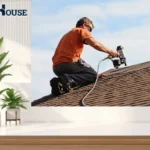One of the most effective ways to achieve this is to replace your roof with modern, weather-resistant materials and employ expert techniques for maximum protection. As homeowners, we often overlook the critical role our roofs play in protecting our homes from the elements.
However, with the increasing frequency of extreme weather events, it’s becoming more important than ever to ensure our roofs are up to the task of weatherproofing our properties.
When you replace your roof, you’re not just swapping out old shingles for new ones. You’re investing in the long-term integrity of your home, safeguarding it against water damage, mold growth, and structural issues that can arise from a compromised roof. Let’s explore the various aspects of roof replacement and weatherproofing that can help you protect your property like a seasoned professional.
Replace Your Roof
The decision to replace your roof is a significant one, but it’s often necessary to ensure optimal weatherproofing. Here are some key considerations when undertaking a roof replacement project:
Choosing the Right Materials
Selecting high-quality roofing materials is crucial for effective weatherproofing. Modern roofing options include:
- Asphalt shingles: These are popular due to their affordability and durability.
- Metal roofing: Known for its longevity and excellent weather resistance.
- Synthetic slate: Offers the aesthetic of natural slate with improved durability and lighter weight.
When choosing materials to replace your roof, consider factors such as your local climate, the slope of your roof, and your budget. Each option has its own set of advantages in terms of weatherproofing capabilities.
Professional Installation
While DIY roof replacement might seem tempting, professional installation is crucial for ensuring proper weatherproofing when you replace your roof. Experienced roofers have the skills to:
- Correctly install underlayment, which provides an essential waterproofing layer.
- Properly seal all joints and flashings to prevent water infiltration.
- Ensure proper ventilation, which is critical for preventing moisture buildup in the attic.
Incorporating Advanced Weatherproofing Techniques
Modern roofing techniques go beyond basic installation to provide superior weather protection:
- Seamless gutter systems: These help efficiently channel water away from your home’s foundation.
- Enhanced flashing techniques: Proper flashing around chimneys, vents, and other roof penetrations is crucial for preventing leaks.
- Ice and water shields: These additional layers provide extra protection in areas prone to ice dams and heavy rainfall.
Waterproofing Solutions for Different Roof Types
Different roof types require specific waterproofing approaches. Let’s examine some effective techniques for various roof styles:
Flat Roof Waterproofing
Flat roofs are particularly vulnerable to water pooling, making waterproofing essential. Some effective techniques include:
- Liquid waterproofing membranes: These form a seamless, flexible barrier when applied to the roof surface.
- Single-ply membranes: Materials like TPO and PVC offer excellent waterproofing properties and are ideal for both commercial and residential flat roofs.
- Modified bitumen: This asphalt-based material is highly water-resistant and can be applied in multiple layers for added protection.
Sloped Roof Waterproofing
While sloped roofs naturally shed water more efficiently, they still require proper waterproofing:
- High-quality shingles: Choose shingles designed to withstand heavy rain and wind.
- Proper underlayment: A waterproof underlayment provides an additional barrier against moisture infiltration.
- Adequate ventilation: Proper attic ventilation helps prevent moisture buildup and ice dam formation.
Maintenance and Ongoing Weatherproofing
Replacing your roof is just the first step in weatherproofing your property. Ongoing maintenance is crucial for ensuring long-term protection:
- Regular inspections: Conduct roof inspections at least twice a year and after severe weather events.
- Prompt repairs: Address any damaged or missing shingles immediately to prevent water infiltration.
- Gutter maintenance: Keep gutters clean and properly aligned to ensure efficient water drainage.
- Trim overhanging branches: Prune nearby trees to prevent damage from falling branches during storms.
Advanced Weatherproofing Technologies
As roofing technology advances, new weatherproofing solutions are emerging:
- Cool roof coatings: These reflective coatings not only improve energy efficiency but also provide an additional layer of waterproofing.
- Smart roofing systems: Integrated sensors can detect moisture buildup and alert homeowners to potential issues before they become serious problems.
- Nano-technology coatings: These ultra-thin coatings provide superior water repellency and can be applied to various roofing materials.
Protecting Your Home During Roof Replacement
When replacing your roof, it’s essential to protect the rest of your property:
- Use tarps: Cover your landscaping and outdoor furniture with tarps to catch debris.
- Install temporary gutters: These can help direct water away from your home’s foundation during the replacement process.
- Use angled boards: Place wooden boards at an angle against your home’s exterior to deflect falling debris.
Replace Your Roof: Innovative Waterproofing Methods
As we look towards the future of roofing technology, several innovative waterproofing methods are gaining traction in the industry. These cutting-edge solutions not only provide superior protection against water infiltration but also offer additional benefits such as improved energy efficiency and environmental sustainability.
Green Roofing Systems
Green roofs, also known as living roofs, are becoming increasingly popular in urban areas. These systems involve installing a layer of vegetation on top of a waterproof membrane. While they require specialized installation techniques, green roofs offer excellent waterproofing properties along with numerous environmental benefits:
- Enhanced insulation, reducing heating and cooling costs
- Improved air quality and reduced urban heat island effect
- Stormwater management through natural filtration and retention
When considering a green roof as part of your roof replacement project, it’s crucial to work with experienced professionals who can ensure proper waterproofing and structural support.
Self-Healing Membranes
One of the most exciting developments in roof waterproofing technology is the emergence of self-healing membranes. These innovative materials contain microcapsules filled with a healing agent. When the membrane is damaged, these capsules rupture and release the agent, which then solidifies and repairs the breach automatically.
This technology has the potential to significantly extend the lifespan of roofing systems and reduce the need for frequent repairs or replacements when you replace your roof. While still in the early stages of commercial application, self-healing membranes represent a promising future for roof waterproofing.
Climate-Specific Considerations for Roof Replacement
When you replace your roof, it’s essential to consider your local climate and how it might impact your roofing needs. Different regions face unique challenges when it comes to weatherproofing:
Hot and Humid Climates
In areas with high temperatures and humidity, such as the southeastern United States, roofing materials need to withstand intense sun exposure and frequent rainfall. Consider these options:
- Reflective roofing materials to reduce heat absorption
- Algae-resistant shingles to prevent unsightly streaking
- Enhanced ventilation systems to combat moisture buildup in the attic
Cold and Snowy Regions
As we look ahead, the roofing industry continues to evolve with new technologies and materials designed to enhance weatherproofing capabilities when you replace your roof. Some exciting developments on the horizon include:
- High-quality ice and water shields, especially at the eaves
- Proper attic insulation and ventilation to prevent heat loss
- Durable materials that can withstand the weight of snow accumulation
Coastal Areas
Homes near the coast face unique challenges due to salt air, high winds, and potential hurricane activity. When replacing your roof in these regions, prioritize:
- Corrosion-resistant materials, such as certain types of metal roofing
- Wind-resistant shingles or tiles rated for high-speed winds
- Enhanced fastening systems to secure roofing materials
By tailoring your roof replacement project to your specific climate, you can ensure optimal performance and longevity of your new roof.
The Future of Roof Weatherproofing
As we look ahead, the roofing industry continues to evolve with new technologies and materials designed to enhance weatherproofing capabilities when you replace your roof. Some exciting developments on the horizon include:
- Photovoltaic roofing materials that integrate solar energy generation with waterproofing
- Advanced drone technology for more accurate and efficient roof inspections
- Artificial intelligence-powered predictive maintenance systems
These innovations promise to make roof replacement and weatherproofing more effective, efficient, and sustainable in the coming years.
Conclusion,
When you decide to replace your roof, you’re not just updating an essential component of your home; you’re investing in a comprehensive weatherproofing solution that protects your entire property.
By understanding the various aspects of modern roofing technology, materials, and installation techniques, you can make informed decisions that will keep your home safe and dry for years to come. Remember, a well-executed roof replacement is more than just a home improvement project – it’s a long-term investment in the safety, comfort, and value of your home.





